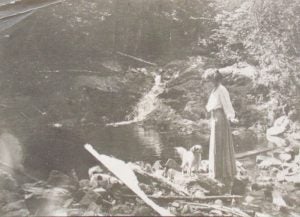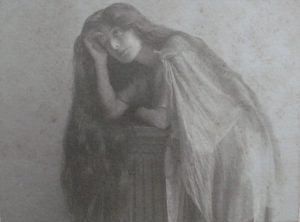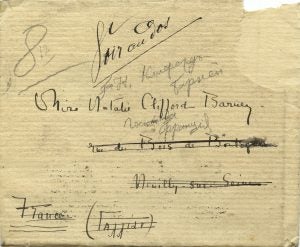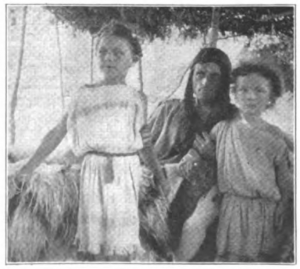Taken from Eva Palmer Sikelianos: A Life in Ruins. Please do not quote without permission. Note that this chronology draws on archival and bibliographic sources listed in detail in the book. Essential sources are the Eva Sikelianou Papers and the Angelos Sikelianos Papers in the Benaki Historical Museum; Eva Sikelianou Papers in the Center for Asia Minor Studies; correspondence in the Natalie Clifford Barney fond in the Bibliothèque littéraire Jacques Doucet; and Κώστας Μπουρναζάκης (Kostas Bournazakis), Χρονογραφία Άγγελου Σικελιανού (1884-1951), «Ίκαρος», Αθήνα 2006. I am grateful for permission granted to draw from these materials in my book.
1874 Eva (Evalina) is born to Courtlandt and Catherine Palmer (Jan. 9), the last of five children (after Robert; Rose, May; and Courtlandt).
1884 Angelos Sikelianos is born to Ioannis and Harikleia Sikelianos in Leukas (March 15), their youngest (after Hector, Menelaos, Eleni, and Penelope).
1886 The Palmers travel to Europe to consult specialists for Courtlandt’s health (May 9). Between 1885 and 1891 Eva attends seven different schools in France, Germany, and the United States.
1888 Courtlandt Palmer dies of peritonitis. His property is put in trust for the lifelong benefit of his heirs.
1888–1891 Eva attends and graduates from Miss Porter’s School in Farmington, Connecticut, a girls’ preparatory school.
1891 Catherine Palmer marries Robert Abbe, a surgeon at St. Luke’s Hospital, and becomes Mrs. Abbe (Nov. 15).

1892 Eva and her family begin spending time in in the summer resort of Bar Harbor, Maine. She and Natalie Clifford begin intimate relations in Bar Harbor, according to Barney’s later memory of events.
1893 Eva makes her debut in New York Society (Dec. 5).
1896 Eva meets President Martha Carey Thomas of Bryn Mawr College (spring); she passes exams and gains entrance into Bryn Mawr (Oct.).
1897 Eva plays Pollie in Frank Daniels’ “The Idol’s Eye,” an operetta by Harry B. Smith and Victor Herbert, at the Broadway Theatre (October).
1898 Mr. and Mrs. Robert Abbe purchase “Brook End,” a summer cottage in Bar Harbor. Eva is caught doing something strictly prohibited and is forbidden the right of residence for a year by President Thomas (May 28). She travels abroad with Courtlandt, Jr., and returns to New York a year later.
1900 Eva is in Bar Harbor with her parents (July–Sept.). Her first extant letter to Natalie Barney is dated July 28. She invites Renée Vivien and Barney to stay in her residence at Bryn Mawr College (fall).
1901 Eva follows Vivien and Barney to Paris and takes acting lessons with Madame le Bargy of the Comédie Française. She meets Sarah Bernhardt. Vivien ends her relationship with Barney.
1902 Mrs. Abbe becomes president of the City Club of New York. Barney receives a substantial inheritance following her father’s death (Dec.). Freed from his scrutiny, she begins living an openly lesbian life.
1903 Eva and Barney share an apartment in Paris (April 1–summer 1904). Eva begins her affair with “Baby” (Bébé) Marie de Hatzfeld, princess of Hohenlohe (1903–1905). Raymond Duncan marries Penelope Sikelianos in Greece.
1904 Dr. Abbe introduces the practice of using radiation therapy for cancer treatment in the U.S. Eva and Barney move into neighboring houses in Neuilly-sur-Seine (summer). Eva travels to Bayreuth with Renée Vivien to attend the Wagner Festival. Barney follows and leaves with Vivien for Lesbos, where they briefly plan to create a Lesbian community. Eva leaves Bayreuth with “Baby” and travels to Venice, then returns to Paris (Aug.–Sept.).

1905 Eva plays Romeo in Romeo and Juliet at Alice Pike Barney’s “Evening at Studio House” in Washington, D.C. (Dec. 28). Life magazine reviews her performance of Romeo and announces that Eva will play Melisande with Mme Sarah Bernhardt in Maeterlinck’s “Pelleas and Melisande” (Dec. 30).
1906 Eva leaves New York for Paris with playwright Constant Lounsbery (Jan.) She meets Raymond and Penelope Duncan and invites them to stay in Neuilly (April). They build a loom and learn to weave together. She follows the Duncans to Greece, dressed now in a Greek tunic. She meets Angelos Sikelianos (Aug.).
1907 Eva takes Angelos to Neuilly, hoping to repair relations with Barney, but after Barney insults Angelos, Eva delivers all her love letters to Barney’s doorstep (summer) and sails for the U.S. with Angelos on the La Lorraine (Aug. 26), causing a national stir with her “goddess-like” dress. She and Angelos marry in an Episcopal ceremony conducted by Rev. Stephen H. Green in French at Bar Harbor (Sept. 9). They return to Leukas. She continues to correspond with Barney.
1908 Eva is living between Leukas and Athens. She begins overseeing her husband’s publications, ordering a luxury printing of his new poem Αλαφροΐσκιοτος (The seer) on Italian watermarked paper of Amalfi with leather binding (released spring 1909). She meets Konstantinos Psachos, Professor of Byzantine Music at the Athens Conservatory (Oct.).

1909 Eva sends Barney two letters asking her not to write again (Jan. 1). A son, Glafkos (Mar. 27–Nov. 1994), is born to Eva and Angelos.
1910 Eva purchases beachfront property in Sykia on the Gulf of Corinth. She travels to Aix-les-Bains to vacation with her mother, seeing her possibly for the last time (May 29).
1912 Eva performs the part of Chrysothemis in Raymond Duncan’s Elektra at Châtelet and Trocadero in Paris. Eva reportedly ends her sexual relationship with Angelos and encourages him to take up relations with his cousin Katina Proestopoulou.
1913 Eva and Glafkos remain in Athens and Sikya while Angelos serves in the Greek Army in the Balkan Wars. Raymond and Penelope Duncan move to southern Albania to care for Greek refugees in the region. Penelope contracts tuberculosis.

1914 Angelos meets Nikos Kazantzakis and travels with him to Mt. Athos (Nov.–Dec.).
1915 Eva begins construction of a villa in Sykia, reportedly designed by Angelos. She oversees publication of his Πρόλογος στη ζωή (Prologue to life), released in 1917. Nikos and Galateia Kazantzakis visit Sykia (Aug.–Sept.). Angelos begins an affair with Nausika Palama, daughter of poet Kostis Palamas (Sept.)
1916 Eva enrolls in the Athens Conservatory as a student of Byzantine music. She meets Dimitri Mitropoulos, then a student of piano and composition, later a world-famous conductor.
1919 Eva addresses the Lyceum of Greek Women, calling on urban women of Greece to take up weaving and reform their dress (May 17). Angelos writes the “Delphic vision,” his first articulation of a Delphic idea (July–Oct.).
1921 Eva lectures against luxury (National Women’s Conference at Parnassus); on Byzantine music (Women of the Lyceum and the Hall of the Archaeological Society); on Greek fashion and local craft industries (both in the Hall of the Archaeological Society) (Feb.). She publishes “Three Lectures.”
1922 (Mar.) Angelos publishes his “Open letter to His Majesty,” a letter anticipating that King Constantine I would lead Greece to a new era of dominance (Mar.). George Cram (“Jig”) Cook, founder of the Provincetown Players, and playwright Susan Glaspell, his wife, arrive in Greece (Mar.). The Asia Minor Catastrophe leaves Angelos in shock (Sept.). He spends the winter in Delphi, where the Cooks are also staying. Kazantzakis cuts his ties with Sikelianos (Dec.).
1923 Angelos is working out his utopian idea of an international brotherhood of elite centered in Delphi. Glaspell, Cook, and Cook’s daughter, Nilla, spend a month with Eva and Angelos in Sykia (May–June). Fourteen-year-old Glafkos falls in love with Nilla. Returning to Delphi for the winter, he announces the creation of the “Delphic Players” with villagers from Delphi.

1924 Cook dies of glanders and is buried in the cemetery of Delphi (Jan.). Eva meets Khorshed Naoroji, a student of piano at the Sorbonne University (Feb.–June). Members of the Writers’ League of Athens organize the George Cram Cook Club and plan to reinstate Delphic theatre performances in his memory (April). Eva and Khorshed launch the Byzantine pipe organ in Germany (late June). Eva brings Khorshed to Greece (July 4) and hosts her in Sikya with Dimitri Mitropoulos, who composes music for several Sikelianos poems. Angelos formally announces his Delphic Idea (Oct. 16). Eva, Khorshed, and Angelos visit Epidaurus, Mycenae, Olympia, Delphi, and the Acropolis in Athens. Khorshed returns to Paris (Oct.–Nov.).
1925 Angelos gives speeches on the Delphic plan (April–Dec.). Eva weaves costumes and trains the chorus in preparation for the Delphic Festival. She builds a house in Delphi. She travels with Angelos and poet Kostis Palamas to Leucas to commemorate the centenary of Aristotelis Valaoritis at his grave in Madouri (June 8). Glafkos leaves Greece for the U.S. in pursuit of Nilla Cook and stays with Mary Hambidge. The New York Times reports that Greek drama will be revived at ancient Delphi. (Oct. 11).
1926 Eva wins the gold medal in the Decorative Arts at International Exposition in Paris for her weaving. She and Angelos move to Delphi. Rabindranath Tagore visits Athens (Nov. 25). Invitations to the Delphic Festival are extended to him, Gandhi, Edouard Schuré, Gabriel Boissy, Mario Meunier, and other international dignitaries. The publishing house Estia prints two hundred copies of Angelos’s “Delphic Idea.”
1927 Angelos oversees the construction of roads and paths and the installation of water pipes in Delphi at Eva’s expense. She mortgages the houses at Sykia and Delphi to cover the expense of hosting international guests. The Delphic Festival takes place (May 9–10), with a performance of Prometheus Bound, athletic games, and Byzantine and folk music in the ancient site and exhibition of handiwork in the modern village. The festival receives positive international coverage but is a financial failure.

1928 Eva invites journalist Alma Reed to move into her seventh-floor apartment at 12 Fifth Avenue near Washington Square in New York. They create the “Ashram,” a salon paying homage to Gandh i’s non-violent activism, with the “Delphic Studies,” a gallery promoting Mexican muralist Jose Clemente Orozco and other artists. Eva’s stepfather, Robert Abbe, dies, leaving an estate of $400,000 (Mar. 28).
1929 Antonis Benakis asks Eva to return to Greece to organize the Second Delphic Festival with funding from private donors and a loan from the National Bank of Greece. The Academy of Athens bestows upon her and Angelos “silver medals” honoring them as the “Phoebus-inspired couple” (March 25). Poet and diplomat George Seferis visits Angelos at Delphi with Édouard Herriot, former Foreign Minister of France (April 21). Glafkos marries Frances LeFevre and settles in Greece (July).
1930 Brastias (Mark) is born to Glafkos and Frances Sikelianos (Mar. 7). The Second Delphic Festival (May 1-3, 6-8, and 11-13) takes place with three performances each of Prometheus Bound, the Suppliants, and Pythian athletic games, followed by Macedonian war dances and torchlight processions. The music is by Psachos, and costumes, choreography, and direction are by Eva. After the event, Psachos breaks ties with Eva. Angelos and Eva Sikelianos meet with government officials, and Eva and Antonis Benakis meet with Prime Minister Venizelos to secure the future of the festivals. A “Lottery of the Delphic Festivals” is announced.
1931 Lawyers and creditors arrive at Sykia to take inventory of the house (Aug. 22).
1932 Angelos completes the play, Dithyramb of the Rose (June 9).
1933 Eva directs two performances of the Dithyramb of the Rose in a wooden open-air theatre she has constructed on the western slope of Philopappos Hill in Athens. Between 15,000 and 100,000 people present ridicule the performance (April 24). Distraught by financial and personal strains, Eva leaves for America (Aug.).

1934 Eva directs Euripides’ Bacchae at Smith College in a large outdoor athletic space with a few props and costumes woven by her and Mary Hambidge. She uses her own choreography and musical compositions (June 15). Meanwhile, the situation with the mortgaged houses remains unsettled.
1935 First Lady Eleanor Roosevelt invites Eva to the White House to speak about her work (Jan.). She begins a 15-year correspondence with Edith Hamilton on the translation and performance of Greek drama (May). The Bacchae is performed twice at Bryn Mawr (June 1, 3).
1936 (Jan.) Eva applies to the Federal Theatre Project (FTP) and is appointed to produce Aeschylus’s Persians with a male chorus hired by the FTP. She exhibits her costumes at the Metropolitan Museum of Art (June–Aug.).
1937 Eva recovers her American citizenship (April 21). She is dismissed by the FTP without explanation (Aug.). She tries to borrow money from her sister May to help Glafkos and Angelos. Angelos informs Eva about his renewed efforts to organize the third Delphic Festival with a performance of the Oresteia, supported by the Metaxas dictatorship. He asks her to return to Greece (Oct. 30).
1938 Eva contracts double pneumonia (Mar.). Mary Hambidge arranges for her care at the Saratoga Sanatorium. While recuperating, she begins writing Upward Panic.
1939 Glafkos and Frances return to the U.S. and divorce. Angelos writes to Eva about his new love, Anna Karamanou, and asks her to sanction the relationship (Mar.). Eva is introduced to Ted Shawn in New York and begins working with him in his summer studio at “Jacob’s Pillow.” She moves to winter studio in Eustis, Florida (Oct.) and weaves costumes for his company’s performances. Shawn pays for publication of Angelos’s Dithyramb of the Rose in Frances LeFevre’s English translation and sends it as a Christmas card.

1940 Shawn and his male dancers perform pieces he and Eva created together in Carnegie Hall (May 9 [AU: Confirm date]). Angelos marries Anna Karamanou in a small church in Eleusis (June 17). Eva has not yet annulled their marriage. Italian forces invade Greece (Oct. 28) and are defeated (October 28). Angelos recites his tragedy Sibyl, about the Delphic Pythia’s rejection of Nero in 59 AD, and sends Eva a copy, asking her to translate and produce it.
1941 Barton Mumaw performs a solo dance “Hellas Triumphant” in Carnegie Hall to honor Greek victory over the Italians, with help from Eva (April 16–17). Eva reports her disagreements with Shawn and moves to Rabun Gap, where she stays for three years.
1942 Glafkos marries Miriam B. Tryon, with whom he has four children (Chris, Jon, Melitsa, and Poppy born in 1943, 1945, 1948, 1951 respectively). Eva is invited to support the Greek War Relief in response to the humanitarian crisis (July).
1943 (Feb. 28) Angelos’s eulogy for Kostis Palamas’s funeral in Nazi-occupied Athens inspires crowds to sing outlawed Greek national anthem (Feb. 28). Eva publishes an open letter, “For Greek War Relief,” drawing parallels between Greece and the U.S. to inspire American support for Greece (April). She is asked to join the progressive, anti-fascist, anti-monarchy League of Greek-American Progressive Men of Letters and Intellectuals.
1944 George Seferis, a diplomat in Greece’s government in exile in Cairo, secretly sends Eva a copy of Angelos Sikelianos’s Akritika, a collection of poems of resistance circulating illegally in occupied Greece, and asks her to translate and publish the collection (Mar. 22). Eva moves back to New York to begin work on the publication. The book, translated with an introduction by Paul Nord, is published by Spap Co. (June). She is interviewed on the “People to remember” weekly series on WINS station, a CBS affiliate in New York (Aug. 20).
1945 The New York PM Daily reports that Eva Sikelianos has sent more than 2,000 letters to educate Americans about Greece (Jan. 12).
1946 Henry Miller and Eva draft a letter nominating Angelos Sikelianos for the Nobel Prize in Literature. (Angelos is nominated nine times between 1946 and 1950). She becomes a member of the Progressive Citizens of America.
1947 Eva drafts a letter to Eleanor Roosevelt on the Greek civil war, denouncing the monarchy.
1948 The House Un-American Activities Committee lists “Eva Sikelianos” as part of the “communist ‘peace’ offensive.”

1949 Eva makes amends with Courtlandt, after years of fighting.
1950 Eva moves into an apartment in Courtland’s building at 64 West 12th Street. She and Angelos are invited by the American Embassy in Athens to direct the “Home-coming Year,” part of the “Return to Greece” tourist campaign supported by the Economic Recovery Program (Marshall Plan).
1951 Eva learns she was denied a visa to Greece because she called the royal family fascists and is considered a communist threat. She refuses to sign a retraction (April). Angelos dies of accidental poisoning (June 19).

1952 Eva is issued a visa and plans to return to Greece. She visits family and friends to say goodbye. She travels to Delphi to attend events celebrating the twenty-fifth anniversary of the Delphic Festivals. She suffers a stroke after the last of four performances of Prometheus Bound. She dies in Evangelismos Hospital in Athens (June 4). The next day, she receives a state funeral in the Cathedral of Athens, then is transported to the cemetery of Delphi for burial between Harikleia Sikelianou and George Cram Cook. Richard N. Crockett, the Palmer family lawyer and executor of the Eva Palmer Sikelianos estate, declares that Eva’s property must remain in Greece according to her stated wishes (June 25). When inventory is taken, five of fifteen cases in Eva’s bill of landing are reported missing (June 25). Anne Antoniades and Angeliki Hadjimihali are issued power of attorney by Glafkos to deal with Eva’s things and ask that the remainder of Eva’s effects in the U.S. be sent to Greece (Oct.).
1959 One of Eva’s costumes, “a chiton and a chlamys,” is donated to the College Theatre of Bryn Mawr for performances of Greek drama.
1960 The Benaki Museum receives forty-one costumes made by Eva for the Delphic Festivals and puts them in storage in anticipation of the resolution of issues surrounding Eva’s estate.
1965 The American Hellenic Union organizes an exhibit dedicated to Eva’s work. The Benaki Museum receives her papers (Dec. 22, with additions in June 1966) with a promise by Octave Merlier to microfilm them.

1969 Merlier visits Barney in Paris and brings to Greece 406 letters from Eva’s correspondence, promising to microfilm and return them. The letters become part of the collection of Eva Sikelianou Papers deposited in the Center for Asia Minor Studies.
1992 Ιερός Πανικός, the Greek translation of Upward Panic, is published by John P. Anton.
1993 Upward Panic: The Autobiography of Eva Palmer-Sikelianos is published by Anton under this title.
1994 Glafkos dies in California (Nov.).
1995 A selection of Eva’s love letters from Barney’s papers in the BLJD are published in Greek translation by Lia Papadaki.
2009 I receive permission to read Eva’s long inaccessible correspondence in the Center for Asia Minor Studies.

